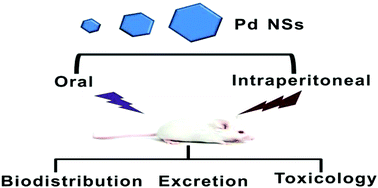当前位置:
X-MOL 学术
›
Biomater. Sci.
›
论文详情
Our official English website, www.x-mol.net, welcomes your feedback! (Note: you will need to create a separate account there.)
The biodistribution, excretion and potential toxicity of different-sized Pd nanosheets in mice following oral and intraperitoneal administration
Biomaterials Science ( IF 6.6 ) Pub Date : 2017-10-09 00:00:00 , DOI: 10.1039/c7bm00769h Xiaolan Chen 1, 2, 3, 4, 5 , Jingchao Li 1, 2, 3, 4, 5 , Yizhuan Huang 1, 2, 3, 4, 5 , Jingping Wei 1, 2, 3, 4, 5 , Duo Sun 1, 2, 3, 4, 5 , Nanfeng Zheng 1, 2, 3, 4, 5
Biomaterials Science ( IF 6.6 ) Pub Date : 2017-10-09 00:00:00 , DOI: 10.1039/c7bm00769h Xiaolan Chen 1, 2, 3, 4, 5 , Jingchao Li 1, 2, 3, 4, 5 , Yizhuan Huang 1, 2, 3, 4, 5 , Jingping Wei 1, 2, 3, 4, 5 , Duo Sun 1, 2, 3, 4, 5 , Nanfeng Zheng 1, 2, 3, 4, 5
Affiliation

|
Two-dimensional (2D) Pd-based nanomaterials with strong near-infrared absorption have recently shown great application prospects in cancer diagnosis and therapy. Most previous studies mainly focused on understanding the in vivo behaviors and treatment effects of these Pd-based nanomaterials after intravenous injection into mice. However, it remains unclear whether other administration routes will affect the in vivo biodistribution, excretion and potential toxicity of Pd-based nanomaterials. In this study, for the first time we systematically explored the in vivo behaviors of different-sized Pd nanosheets (NSs) (approximately 5 nm, 30 nm and 80 nm) following oral feeding and intraperitoneal injection. It was found that Pd NSs with oral administration had a rather low accumulation that decreased with time in all examined organs, and became almost undetectable in these organs at 24 h post-injection. In comparison, the intraperitoneally injected Pd NSs exhibited obvious time-dependent and size-dependent accumulations in the reticuloendothelial (RES) system including the liver and spleen within 24 h post-injection, and then the accumulation amounts decreased with the lapse of time. Moreover in tumor tissue, smaller-sized Pd NSs (5 nm) had a higher uptake than larger-sized Pd NSs (30 nm and 80 nm). Excretion studies uncovered that more than 70% ID of Pd NSs could be rapidly excreted from the body through urine and feces within two days after oral administration, whereas Pd NSs with intraperitoneal injection could be gradually cleared, mainly via urine within 8 days. Further histological examination of organ sections and blood biochemical analysis evidenced that these different-sized Pd NSs do not cause obvious toxicity in the treated mice at the tested period with the given dose. These results not only indicate that the biodistribution and excretion capabilities of Pd NSs are closely related to their administration routes, but also imply that the intraperitoneally injected Pd NSs have greater potential for in vivo biomedical studies compared to oral feeding, because of their relatively higher tissue absorption and gradual excretion from the body. This study will provide valuable information for the clinical translation of 2D Pd-based nanomaterials.
中文翻译:

口服和腹膜内给药后不同大小的Pd纳米片在小鼠中的生物分布,排泄和潜在毒性
具有强大的近红外吸收能力的二维(2D)Pd基纳米材料最近在癌症诊断和治疗中显示出巨大的应用前景。先前的大多数研究主要集中在了解这些基于Pd的纳米材料在静脉注射入小鼠后的体内行为和治疗效果。然而,尚不清楚其他给药途径是否会影响基于钯的纳米材料的体内生物分布,排泄和潜在毒性。在这项研究中,我们第一次系统地探索了体内口服喂食和腹膜内注射后不同大小的Pd纳米片(NSs)(约5 nm,30 nm和80 nm)的行为 发现口服Pd NSs的蓄积量很低,在所有检查的器官中随时间减少,并且在注射后24 h在这些器官中几乎无法检测到。相比之下,腹膜内注射的Pd NSs在注射后24 h内在包括肝和脾在内的网状内皮(RES)系统中表现出明显的时间依赖性和大小依赖性累积,然后累积量随时间的流逝而减少。此外,在肿瘤组织中,较小尺寸的Pd NSs(5 nm)比较大尺寸的Pd NSs(30 nm和80 nm)具有更高的摄取。在8天内通过尿液。器官切片的进一步组织学检查和血液生化分析表明,在给定剂量下,这些不同大小的Pd NSs在测试期间不会对治疗小鼠产生明显的毒性。这些结果不仅表明Pd NSs的生物分布和排泄能力与其给药途径密切相关,而且还表明与口服喂养相比,腹膜内注射的Pd NSs具有更高的体内生物医学研究潜力,因为它们的组织相对较高。从体内吸收并逐渐排泄。这项研究将为2D Pd基纳米材料的临床翻译提供有价值的信息。
更新日期:2017-11-22
中文翻译:

口服和腹膜内给药后不同大小的Pd纳米片在小鼠中的生物分布,排泄和潜在毒性
具有强大的近红外吸收能力的二维(2D)Pd基纳米材料最近在癌症诊断和治疗中显示出巨大的应用前景。先前的大多数研究主要集中在了解这些基于Pd的纳米材料在静脉注射入小鼠后的体内行为和治疗效果。然而,尚不清楚其他给药途径是否会影响基于钯的纳米材料的体内生物分布,排泄和潜在毒性。在这项研究中,我们第一次系统地探索了体内口服喂食和腹膜内注射后不同大小的Pd纳米片(NSs)(约5 nm,30 nm和80 nm)的行为 发现口服Pd NSs的蓄积量很低,在所有检查的器官中随时间减少,并且在注射后24 h在这些器官中几乎无法检测到。相比之下,腹膜内注射的Pd NSs在注射后24 h内在包括肝和脾在内的网状内皮(RES)系统中表现出明显的时间依赖性和大小依赖性累积,然后累积量随时间的流逝而减少。此外,在肿瘤组织中,较小尺寸的Pd NSs(5 nm)比较大尺寸的Pd NSs(30 nm和80 nm)具有更高的摄取。在8天内通过尿液。器官切片的进一步组织学检查和血液生化分析表明,在给定剂量下,这些不同大小的Pd NSs在测试期间不会对治疗小鼠产生明显的毒性。这些结果不仅表明Pd NSs的生物分布和排泄能力与其给药途径密切相关,而且还表明与口服喂养相比,腹膜内注射的Pd NSs具有更高的体内生物医学研究潜力,因为它们的组织相对较高。从体内吸收并逐渐排泄。这项研究将为2D Pd基纳米材料的临床翻译提供有价值的信息。


























 京公网安备 11010802027423号
京公网安备 11010802027423号